Published: October 2000

Since the early days of flight, angle of attack (AOA) has been a key aeronautical-engineering parameter and is fundamental to understanding many aspects of airplane performance, stability, and control. Virtually any book on these subjects, as well as basic texts and instructional material written for flight crews, defines AOA and discusses its many attributes.
AOA can be used for many indications on the flight deck to improve flight crew awareness of airplane state relative to performance limits. Dedicated AOA indicators have been used on military aircraft for many years, but this form of display has not been used often on commercial airplanes. On Boeing models currently in production, AOA is used to drive stall warning (stick shaker), stall margin information on airspeed indicators, and the pitch limit indicator (PLI) on the primary attitude displays. AOA information is combined with other data and displayed as an integral part of flight deck displays.
Recent accidents and incidents have resulted in new flight crew training programs for upset recovery and terrain avoidance, and these in turn have heightened industry interest in AOA as a useful flight parameter for commercial aviation.
The U.S. National Transportation Safety Board (NTSB) has recommended visual indication of AOA in commercial airplanes. This indication may take the form of a dedicated AOA indicator or other implementation, such as the PLI.
A dedicated AOA indicator shown on the primary flight display (PFD) recently has been developed in cooperation with airline customers. The new indicator is offered as an option on the 737-600/-700/-800/-900, 767-400, and 777 at this time.
During the development of the new indicator, discussions with airlines, the NTSB, and U.S. Federal Aviation Administration (FAA) pilots and engineers provided a unique opportunity to examine potential uses of AOA and the many existing uses that have evolved in recent decades along with advances in display and indication technology.
This article discusses the following:
- Basic principles of AOA.
- Airplane performance and AOA.
- AOA measurement.
- AOA indications and flight crew procedures in current Boeing production models.
- Design and uses of a separate AOA indicator.
1. BASIC PRINCIPLES OF AOA
 AOA is one of the most important parameters for understanding airplane performance and handling (see “What Is Angle of Attack?”) because a typical wing has a limited range of angles of attack over which it can function efficiently. In its simplest form, lift is a function of speed, air density, wing area, and AOA. At a given airspeed, as the AOA of a wing is increased, lift also will increase (figure 1). Therefore, at the same airspeed, a heavy airplane of the same configuration must fly at a higher AOA than a light one. Conversely, as an airplane decelerates, the AOA must be increased to maintain the same lift. So, in the normal operational range, there is a relationship among lift, speed, and AOA.
AOA is one of the most important parameters for understanding airplane performance and handling (see “What Is Angle of Attack?”) because a typical wing has a limited range of angles of attack over which it can function efficiently. In its simplest form, lift is a function of speed, air density, wing area, and AOA. At a given airspeed, as the AOA of a wing is increased, lift also will increase (figure 1). Therefore, at the same airspeed, a heavy airplane of the same configuration must fly at a higher AOA than a light one. Conversely, as an airplane decelerates, the AOA must be increased to maintain the same lift. So, in the normal operational range, there is a relationship among lift, speed, and AOA.
This relationship will change if the AOA gets too high (figure 1). The air flowing over the wing will separate from the upper surface, resulting in a loss of lift, or a stall. It should be noted that this stall condition could occur at a wide range of speeds (depending on the airplane weight or load factor, or g loading) and at any attitude (depending on the flight path angle). What is important is the AOA. Therefore, it is imperative to know when the wing is approaching the stall AOA and to take steps to avoid it.
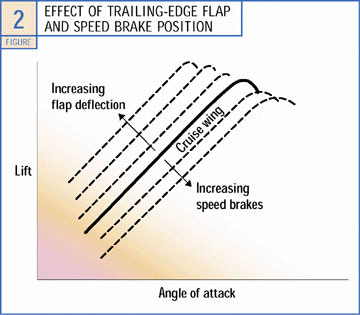 However, many other parameters influence the lift that a wing produces. The most basic is the configuration of the wing, specifically the position of the trailing-edge flaps, leading-edge flaps or slats, and spoilers. As the trailing-edge flaps are extended, the curvature (or camber) and area of the wing are increased, and the wing will produce more lift at the same AOA (figure 2).
However, many other parameters influence the lift that a wing produces. The most basic is the configuration of the wing, specifically the position of the trailing-edge flaps, leading-edge flaps or slats, and spoilers. As the trailing-edge flaps are extended, the curvature (or camber) and area of the wing are increased, and the wing will produce more lift at the same AOA (figure 2).
Note that although the maximum lift is increased, the AOA at which stall occurs is actually less because the wing cannot sustain the higher lift levels up to the same AOA. The airflow separates earlier.
Wing-mounted speed brakes or spoilers have the opposite effect. They reduce the lift at a given AOA; they also reduce the maximum lift achievable but, surprisingly, increase the AOA at which stall occurs.
 Leading-edge devices, such as Krueger flaps and slats, permit the wing to operate at a higher AOA before it stalls by delaying the flow separation. Figure 3 illustrates this and the effect of contamination, such as ice or dents, on the leading edge. Contamination can cause the airflow to separate at a lower AOA, causing the wing to stall at a lower AOA than expected. While these effects are accounted for in the airplane design and maintenance program, it is important to remember this potential variability in stall AOA (see "Winter Operations—Keep It Clean," Airliner, Oct.–Dec. 1983).
Leading-edge devices, such as Krueger flaps and slats, permit the wing to operate at a higher AOA before it stalls by delaying the flow separation. Figure 3 illustrates this and the effect of contamination, such as ice or dents, on the leading edge. Contamination can cause the airflow to separate at a lower AOA, causing the wing to stall at a lower AOA than expected. While these effects are accounted for in the airplane design and maintenance program, it is important to remember this potential variability in stall AOA (see "Winter Operations—Keep It Clean," Airliner, Oct.–Dec. 1983).
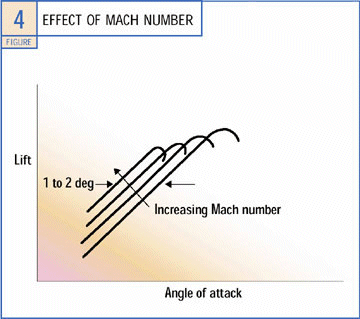 On most transport category airplanes, the lift that the wing produces is also a function of Mach number, particularly as the airplane approaches transonic speeds typical of cruise flight (figure 4).
On most transport category airplanes, the lift that the wing produces is also a function of Mach number, particularly as the airplane approaches transonic speeds typical of cruise flight (figure 4).
Of course, lift at a given AOA will increase with speed, but even at the same airspeed, as Mach number is increased (the speed of sound changes with temperature), lift will increase.
However, higher Mach reduces the maximum lift the wing can attain and the AOA at which stall occurs. This means that as gross weight, altitude, or load factor is increased, the resultant increase in Mach number will cause a stall at a higher speed and lower AOA. This is true even at takeoff and landing speeds with the flaps down.
 The centre of gravity (CG) also affects the lift that the wing must produce. As the CG moves forward, the nose-down moment increases because of the airplane weight and wing lift (figure 5).
The centre of gravity (CG) also affects the lift that the wing must produce. As the CG moves forward, the nose-down moment increases because of the airplane weight and wing lift (figure 5).
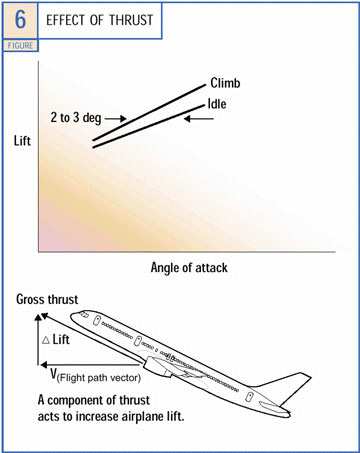 Therefore, the down-force on the horizontal tail required to trim is increased. This means that the wing must provide enough lift to compensate for the download on the tail in addition to the weight of the airplane. Note that the AOA of stall is not changed, but the lift required of the wing is greater, and therefore the stall speed is increased.
Therefore, the down-force on the horizontal tail required to trim is increased. This means that the wing must provide enough lift to compensate for the download on the tail in addition to the weight of the airplane. Note that the AOA of stall is not changed, but the lift required of the wing is greater, and therefore the stall speed is increased.
Thrust also can affect lift in three ways. First, the component of thrust that acts in the lift direction offsets some of the lift required of the wing (figure 6). Therefore, as thrust is increased, the AOA for trimmed flight is reduced and the maximum lift is increased. Second, thrust changes the airflow around the wing and flaps, which does not usually have a large effect on jet transport airplanes. Third, thrust affects airplane trim, usually by reducing the download on the tail (see previous paragraph on CG).
The examples cited above show that many parameters affect the relationship of lift and AOA. For AOA information to be useful to a flight crew, these parameters must be considered and accounted for in the indications and associated crew procedures.
2. AIRPLANE PERFORMANCE AND AOA
Takeoff. During rotation, pitch angle is the critical parameter that ensures tail clearance. Once the airplane is airborne and at a sufficient altitude where ground effect and crosswinds do not affect the sensor reading, AOA will provide valid information.
During takeoff climb, there is no single target AOA to fly that will guarantee certified takeoff performance. Takeoff-climb AOA will vary with such factors as airplane gross weight, thrust, altitude, flap setting, and CG. Takeoff-climb speeds (hence, AOA) are limited by stall speed, tail clearance, and minimum control speeds. The higher speed and greater thrust of an all-engine takeoff reduce the AOA significantly relative to an engine-out takeoff at the engine-out climb speed (V2 ).
The key to optimal takeoff performance is to "fly the speeds." The takeoff flight path that guarantees clearance of all obstacles ahead is calculated based on flight at these speeds. Following rotation at VR , V2 is the resulting engine-out speed at an altitude of 35 ft and is usually slower than that for best lift-to-drag (L/D) ratio or angle of climb. However, if the nose were to be kept down and the airplane accelerated to higher speeds, short-term climb performance would be sacrificed and a close-in obstacle may not be cleared.
Cruise. Range is a function of both the aerodynamics of the airplane and the fuel-flow characteristics of the engines. Aerodynamically, the minimum drag point occurs at the point where the L/D is a maximum. But this value depends on both AOA and Mach number, so the optimal AOA will vary as Mach number is changed.
The fuel-flow characteristics of the engines are not affected by AOA, but they do depend on the thrust required (drag), Mach number, and temperature.
 Combining the wing and engine characteristics yields the fuel mileage of the airplane, so fuel mileage is a strong function of Mach number. Figure 7 shows the fuel mileage of a 757-200 at an altitude of 35,000 ft as a function of gross weight and Mach number. It can be seen that the optimal long-range cruise Mach number does not vary significantly as gross weight (hence, lift and AOA) changes. Superimposed on this chart are two lines of constant AOA. It is apparent that flying a constant AOA will not yield optimal performance. If a flight crew tried to fly a target AOA and there was an error of as little as 0.5 deg, the penalty in fuel mileage could be 3 percent or more.
Combining the wing and engine characteristics yields the fuel mileage of the airplane, so fuel mileage is a strong function of Mach number. Figure 7 shows the fuel mileage of a 757-200 at an altitude of 35,000 ft as a function of gross weight and Mach number. It can be seen that the optimal long-range cruise Mach number does not vary significantly as gross weight (hence, lift and AOA) changes. Superimposed on this chart are two lines of constant AOA. It is apparent that flying a constant AOA will not yield optimal performance. If a flight crew tried to fly a target AOA and there was an error of as little as 0.5 deg, the penalty in fuel mileage could be 3 percent or more.
Wind is a more fundamental consideration. For best fuel mileage in a headwind, the airplane should be flown faster than the speed for best range in still air; in a tailwind, it should be flown more slowly. Most modern Boeing airplanes have a flight management computer (FMC) that accounts for airplane, engine, and wind characteristics and can compute the optimal speed to be flown.
Approach speed. Approach speed is critical to landing performance and is established during the airplane certification process. It is determined not only by margin above stall speed but also may be increased by consideration of minimum control speed and tail clearance at touchdown.
 Regulations require that the approach speed be no smaller than a specific multiple of the stall speed. Because stall speed is a function of Mach number, stall-limited approach speed will occur at a different AOA at different gross weights and altitudes (figure 8). Those airplanes that do not account for the variation of stall speed with Mach number set the approach speed at the most conservative altitude. The speeds also allow for the most adverse CG (forward) that requires the most lift out of the wing, resulting in the highest stall speed and, therefore, the highest approach speed.
Regulations require that the approach speed be no smaller than a specific multiple of the stall speed. Because stall speed is a function of Mach number, stall-limited approach speed will occur at a different AOA at different gross weights and altitudes (figure 8). Those airplanes that do not account for the variation of stall speed with Mach number set the approach speed at the most conservative altitude. The speeds also allow for the most adverse CG (forward) that requires the most lift out of the wing, resulting in the highest stall speed and, therefore, the highest approach speed.
In addition, the approach speed cannot be smaller than a multiple of the minimum control speed in the landing configuration (Vmcl). This speed is not significantly influenced by movement of the CG. So, during an approach at the aft CG, if the flight crew reduces speed to fly at the same AOA as required for the forward CG, an approach speed below the minimum control speed may result.
A further consideration is the clearance of the aft body from the ground as the airplane lands. Some airplanes, particularly those with stretched fuselages, have increased approach speeds to reduce the AOA and hence the pitch angle on touchdown. This provides adequate clearance between the body and the ground at the most critical CG. However, in revenue service, CG is rarely at the forward limit. So, if the approaches were flown on a daily basis by reference to a fixed-approach AOA based on a margin above stall, at any CG aft of the forward limit, the probability of tail strike would be greater than the current practice of using approach airspeeds.
In addition, variations in thrust will affect the approach AOA-speed relationship.
From the discussion above, it can be seen that approach speed may be limited by many different requirements and that no single AOA can be targeted to ensure proper speed or landing attitude margins.
3. AOA MEASUREMENT
The previous section dealt with the relationship between the aerodynamics of the airplane and the true AOA of the wing. In practice, the true AOA of the wing is not known. It only can be estimated based on a measuring device mounted somewhere on the airplane. Any such device has inherent errors that must be addressed.
Wherever the device is located, it is measuring the flow angle in its own local vicinity, not at the wing. Stall warning devices have been mounted on the wing, but most modern commercial jet airplanes have movable leading edges that would interfere with such an installation. Most have the sensor located on the fuselage, far ahead of the wing, reducing the effect of changes in lift and configuration. Nearer to the nose of the airplane, the airflow is relatively clean and the boundary layer is thin, minimising the required probe height.
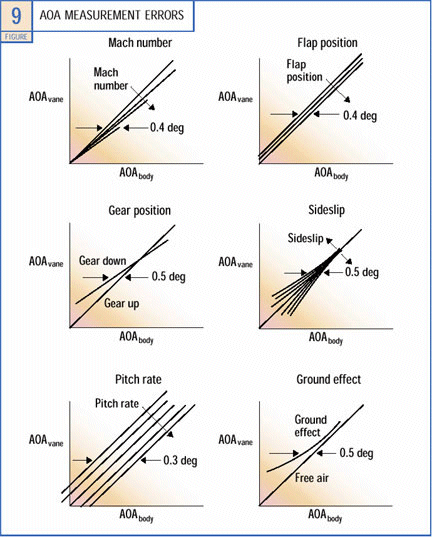 Even at the nose, many factors can affect the relationship between the local AOA and true wing AOA (figure 9). The angle of airflow around the nose is not the same as at the wing.
Even at the nose, many factors can affect the relationship between the local AOA and true wing AOA (figure 9). The angle of airflow around the nose is not the same as at the wing.
Also, the sensitivity to changes in AOA is greater, so a 1-deg change in true wing AOA causes a local flow change at the nose of 1.5 to 2 deg. The trailing-edge flap position has an influence on a typical AOA sensor calibration, as has landing gear position (in particular, that of the nose landing gear doors). Mach number affects the flow around the nose and therefore changes the sensor calibration.
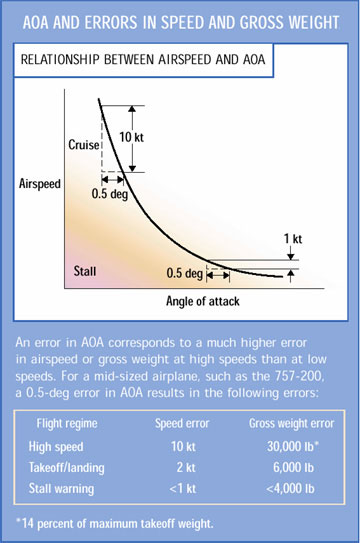 Pitching the airplane can cause erroneous readings at the sensor. While the nose is pitching up (as in a turn), the local flow angle is reduced, causing the reading to be too low. Although the sensors are placed to minimise the effect of sideslip, it is not eliminated and can be quite significant at sideslip angles that may occur on short final approaches or with an engine out.
Pitching the airplane can cause erroneous readings at the sensor. While the nose is pitching up (as in a turn), the local flow angle is reduced, causing the reading to be too low. Although the sensors are placed to minimise the effect of sideslip, it is not eliminated and can be quite significant at sideslip angles that may occur on short final approaches or with an engine out.
Even variations in the contour of the skin near the sensor can subtly affect the local flow angle. Many of these design challenges also affect pitot and static port installation and accuracy.
The sensor itself has potential for error. The combination of installation error, zero bias, and aerodynamic inaccuracy can total 0.5 deg or more. Contamination or damage can also affect the sensor's accuracy.
For the most part, the effects discussed above can be compensated for and, depending on the airplane, many have been. It should be noted, however, that each correction has its own inherent uncertainty and can also cause erroneous readings if the input data is incorrect.
In the philosophy of "keep it simple," the fewer dependencies on other data, the more robust the AOA system will be. For example, Mach number affects the sensor calibration. While this relationship could be compensated for, this would make the sensor output dependent on good Mach information. If the airspeed data were inaccurate, the calculated Mach number and therefore the calibrated AOA reading would be incorrect. This would affect the usefulness of AOA in the event of an airspeed system failure. Note that because the sensors are located near the nose and the air data probes, certain conditions, such as radome damage or loss, may cause erroneous measurement of AOA as well as airspeed.
4. AOA INDICATIONS AND FLIGHT CREW PROCEDURES IN CURRENT BOEING PRODUCTION MODELS
AOA is most useful to the flight crew at high angles of attack to show the margin to stall or stall warning. All indications driven by AOA—stick shaker, PLI, and speed tape indications—are related to this important information.
Stick shaker. An artificial stall warning system is required for airplane certification if the natural pre-stall buffet characteristics of the airplane are insufficient to warn the flight crew of an impending stall. This warning must be in a form other than visual to be effective, even if the flight crew is not looking at the instrument panel. Beginning with early commercial jetliners, standard practice has been to equip these airplanes with a stick shaker as a means of stall warning. Some airplanes also have employed stick nudgers or stick pushers to improve stall avoidance and stall characteristics. All these indications have been driven by an AOA threshold, which is usually a function of flap configuration, landing gear configuration, or both.
Because of the effect of Mach number on stall AOA, the stall warning AOA typically was set at a conservative level to accommodate gross weight and altitude variations expected in the terminal area. The early stall warning system thresholds were not set to be effective at cruise altitudes and speeds because they did not correct for Mach number (figure 10). This kept the system simple. The stick shaker was set at an AOA effective for low altitudes but at too high a value for cruise. Natural stall buffet was found to give satisfactory warning at higher Mach numbers.
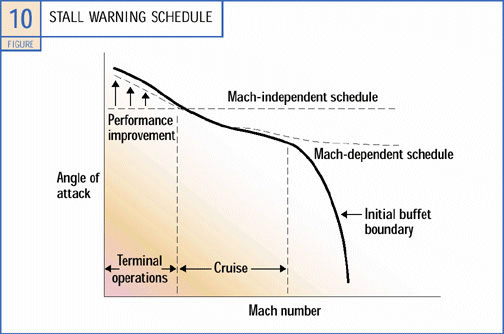
Later stall warning systems used Mach number from the pitot or static air data system to adjust the stall warning AOA threshold down as Mach number increased. This provided the flight crew with a stall warning related to the actual available performance. However, it also made the stall warning system dependent on good pitot and static data, a factor that will be considered in the next section on the dedicated AOA indicator.
It should be noted from figure 10 that the stall warning schedule does not follow the buffet boundary at very high Mach numbers. The buffet here is caused by Mach buffet, or too high a speed. Setting the stall warning system to activate at this point may lead the flight crew to believe the airplane is near stall and increase, rather than decrease, speed.
Pitch limit indicator. The PLI originally was developed as part of an industry effort to address windshear escape training. Because stall warning is primarily a function of AOA, the PLI shows AOA margin to stall warning, even though it is part of the pitch attitude display (figure 11). The distance from the airplane symbol to the PLI is calculated from the difference between the AOA of the airplane and the AOA at which stall warning will occur. This provides the flight crew with good situational awareness, enabling them to monitor airplane attitude in pitch and roll relative to the horizon, while simultaneously showing whether the airplane is approaching its maximum AOA. In general, when the airplane symbol and the amber PLI bars meet, the stall warning system will activate.

However, the PLI also is limited to 30 deg of pitch attitude, regardless of AOA. If AOA or AOA margin to stick shaker were to be used as the first and primary focus of the flight crew during windshear escape or terrain avoidance procedures, extremely high pitch attitudes could be reached before stall warning if the manoeuvre is entered with sufficient speed. Therefore, the PLI shows the lesser of either margin to stick shaker, or 30 deg of pitch.
Because stall AOA is a function of Mach number, a PLI on airplanes with fixed stall warning schedules would display an excessively large margin at typical cruise Mach and altitude. To avoid this misleading display, PLI was available only with flaps extended when it was introduced in the mid-1980s. Later airplanes have employed stall warning schedules that adjust the stall warning threshold as a function of Mach number. The design of the 777, 717, and 767-400ER has taken advantage of this and will display the PLI full time when flaps are down, as well as when flaps are up if speed or load factor causes stall margin to decrease to an AOA within 1.3 g of stall warning.
Work is currently under way to introduce this type of PLI indication on other models. Recent changes to the 757 and 767 enable the PLI to be displayed with flaps up.
Speed tape indications. Soon after the introduction of the PLI, a vertical scale airspeed indicator was developed and added to electronic flight displays. This offered the opportunity to calculate and place airspeed-related data such as maximum, minimum, manoeuvring, and reference speeds on the airspeed instrument (fig. 11). All Boeing models currently in production have this capability.
Of particular interest are the minimum speed amber and red bands, or barber pole. At low speeds on Boeing-designed airplanes currently in production, these indications are based on sensed AOA and the AOA margin to stick shaker. At higher Mach numbers, most airplanes with fixed AOA stall warning schedules show margins to stick shaker or margin to initial buffet, whichever corresponds to the highest speed. On these airplanes, the margin to buffet at higher Mach numbers is calculated by the FMC.
On newer models, such as the 777 and 767-400, the amber and red bands show margin to stall warning at all times because the stall warning schedule generally follows the initial buffet boundary at higher speeds up to cruise. The position of the amber and red bands is always a function of AOA margin to stall warning.
The speed tape is designed to provide the flight crew with situational awareness of the flight envelope. It shows the crew where the airplane speed is relative to the limits (i.e., maximum placard speeds or minimum stall warning speed, as well as the manoeuvring capability available).
5. DESIGN AND USES OF A SEPARATE AOA INDICATOR
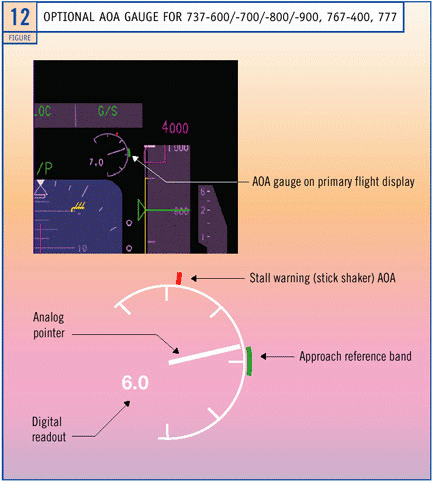 Boeing and several operators worked together to develop the display format for an optional AOA indicator (figure 12). The upper right location was chosen as one that can be accomplished without significant rearrangement of the existing PFD or electronic flight display formats. The indicator itself consists of an analogue scale and pointer, and digital representation similar to displays of many other parameters throughout the flight deck.
Boeing and several operators worked together to develop the display format for an optional AOA indicator (figure 12). The upper right location was chosen as one that can be accomplished without significant rearrangement of the existing PFD or electronic flight display formats. The indicator itself consists of an analogue scale and pointer, and digital representation similar to displays of many other parameters throughout the flight deck.
Stall warning AOA is shown with a red tick mark, which will change position as a function of Mach number for those airplanes with Mach-dependent stall warning schedules. A green approach reference band is shown whenever landing flaps are selected. The range of the approach reference band accounts for normally expected variations in CG, thrust, sideslip, and other considerations.
Many AOA indicators used in the past have been of the "normalised" type, where AOA is shown in arbitrary units and scaled so that zero load factor is shown as an AOA of zero and stall is shown as an AOA of one. Normalised AOA on a commercial jetliner would require that Mach number be introduced into the calculation of AOA because stall AOA and buffet margins are a function of Mach number.
The indicator developed shows body AOA in degrees and is not normalised, which is related to the second objective above, that the indicator be useful when pitot or static data, and therefore Mach calculations, are unreliable because of blockage or a fault in the system. The pointer of a normalised indicator in this condition would behave erratically, making the indicator unusable. With the non-normalised design, the position of the needle is a function only of sensed AOA. The red tick mark for stall warning may behave erratically in a pitot or static failure state, as may stick shaker, PLI, and speed tape amber and red bands. However, the AOA needle and digits will remain stable, and the indicator itself still will be useful as a backup for unreliable airspeed, provided the AOA vanes are undamaged.A variety of potential uses for AOA were examined during the design of the new AOA indicator:
- Improved situational awareness and flight crew training.
- AOA backup indication following pitot or static system failures.
- Reference during upset recovery, windshear escape, and terrain avoidance manoeuvres.
- Indication of maximum L/D or range, detection of weight errors, and a check of fuel consumption during cruise.
- Cross-check to detect weight or configuration errors on approach to reduce the probability of tail strikes on landing.
AOA can be used for some of these purposes, but it does not work as well for others. From the standpoint of flight operations, some of the goals can be met with certain caveats that take into account the principles and limitations of AOA measurement and aerodynamic performance of modern commercial jet airplanes.
Improved situational awareness and flight crew training. There is a desire to use AOA information to increase the flight crew's understanding of the physics of flight and their general awareness of the state of the wing during normal and non-normal conditions. Within certain limitations, the display provides this indication in a clear, unambiguous format. The degree to which AOA can be used to increase knowledge and airmanship depends, of course, on the approach taken by the airline in training its flight crews and the use of the indicator in training scenarios for non-normal procedures. Some of the limitations are discussed below.

Pitot or static system failure requires the flight crew to take several fundamental steps to resolve the problem (see "Erroneous Flight Instrument Information," Aero no. 8, Oct. 1999):
- Recognise an unusual or suspect indication.
- Keep control of the airplane with basic pitch and power skills.
- Take inventory of reliable information.
- Find or maintain favourable flying conditions.
- Get assistance from others.
- Use checklists.
Recognition of a problem will be accomplished by instrument scanning and cross-check practices or crew alerts, depending on the design of the system in the airplane. In this respect, AOA instruments can be useful as an additional cross-check.
Present procedures for unreliable airspeed call for flying the airplane by reference to pitch attitudes, and refer the pilots to reference tables showing pitch attitudes for various configurations, weights, and altitudes that will result in safe angles of attack and speeds. AOA could be useful if the relevant data is included in the pitch and power tables that already exist in the non-normal checklist procedures. AOA would be most useful in flying the airplane in multiple failure conditions where all pitot or static sources are affected, making all airspeed indicators unreliable.
Care should be taken when flying the airplane by reference to AOA in lieu of airspeed. Control should be made by reference to pitch attitude, using AOA as a cross-check to ensure that the pitch attitude results in the desired speed or AOA. Attempting to follow AOA or speed indications too closely without stabilising the airplane in pitch can lead to an oscillatory flight path.
Reference during upset recovery, windshear escape, and terrain avoidance manoeuvres. Windshear escape and terrain avoidance manoeuvres require immediate change in pitch attitude and thrust, followed by monitoring of the situation and further increases in pitch attitude if needed, while avoiding stick shaker activation. The PLI was developed primarily with these purposes in mind and works well. On all current production models, PLI is shown when flaps are down. At this time, PLI is available with flaps retracted on the 717, 767-400, 777, and MD-11. Work is under way to make this capability available on other Boeing-designed models currently in production. The first steps in windshear escape and terrain avoidance procedures involve applying maximum certified thrust and control of airplane pitch attitude to an initial target, while honouring stall warning. AOA margin to stick shaker, whether shown with the PLI or the AOA display, is a secondary reference during this part of the manoeuvre, not the primary target. As mentioned in the section on PLI, pitching up by sole reference to AOA-based indications can result in excessively high pitch attitudes if the manoeuvre is entered at sufficiently high speeds. Because the AOA display is separate from the pitch attitude display, it does not provide protection against high pitch attitudes if the indicator is used as the flight crew's primary focus or target during such manoeuvres. For upset recovery, either the PLI or the red stall warning mark on the AOA indicator may be used to assess the margin to stall warning.
Indication of maximum L/D or range, detection of weight errors, and a check of fuel consumption during cruise. As shown in the section on airplane performance, AOA is not the appropriate parameter for optimising cruise flight, because of the strong influence of Mach number on airplane performance. Because AOA is not very sensitive to speed or weight changes at cruise speeds, even large gross weight errors may not be detectable. A 0.5-deg error in AOA is equivalent to 30,000 lb on a 757-200, or approximately 14 percent of the maximum takeoff weight.
Cross-check to detect weight or configuration errors on approach to reduce the probability of tail strikes on landing. AOA can be used during approach as an extra cross-check for errors in configuration, weight, or reference speed calculation. Proximity of the barber pole to the reference speed on the airspeed tape can be used in a similar manner because it is based on AOA margin to stick shaker. However, for either method, the errors must be large enough that they are not masked by other factors.
Normal variations in AOA as a result of the regulatory requirements on approach speed, as well as those caused by differences in thrust, CG, sideslip, and the installed accuracy of the AOA measurement system, may act together to mask all but large errors in weight or configuration. These factors are taken into account in determining the size of the green approach reference band. To keep the size of the green band from becoming too large, these variations were root-sum-squared because of the low probability that they would all add in the same direction at any one time. The resulting green band is about 2 deg wide for the 777 and 3 deg for the 737. The band is centred at an AOA equivalent to V ref +5 kt, assuming a nominal gross weight, mid-CG, no sideslip, a stabilised 3-deg glideslope thrust level, and no system error.
A 20,000-lb weight error on a 757, corresponding to approximately 10 percent of maximum landing gross weight or about a 40 percent error in payload, yields a change in AOA of 1.7 deg. So, it can be seen that even relatively large weight errors may not be enough to move the needle out of the green band. Conversely, it is also possible that flying at the proper speed and configuration may yield an AOA that is outside the reference band. Figure 13 illustrates how errors can be masked or cancelled out by variation in the other parameters.
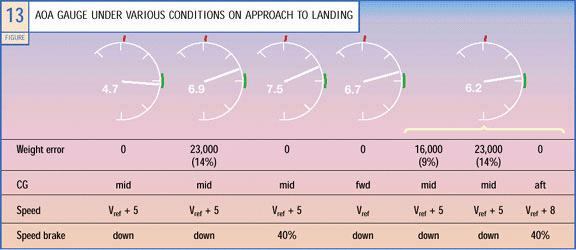
For these and other reasons, the AOA indicator can be used as an additional means to check for large errors in weight or configuration, but it should not be used as a substitute for current procedures to establish approach speeds and verify configurations. To determine the approach speed based solely on placing AOA in the green band can cause situations of excessively high or low approach speeds, depending on a variety of circumstances.
SummaryAOA is a long-standing subject that is broadly known but one for which the details are not broadly understood. While AOA is a very useful and important parameter in some instances, it is not useful and is potentially misleading in others.
|
JOHN E. CASHMAN
DIRECTOR
FLIGHT OPERATIONS
BOEING COMMERCIAL AIRPLANES GROUP
BRIAN D. KELLY
TECHNICAL FELLOW
FLIGHT CREW OPERATIONS INTEGRATION
BOEING COMMERCIAL AIRPLANES GROUP
BRIAN N. NIELD
MANAGER
AERODYNAMICS ENGINEERING
BOEING COMMERCIAL AIRPLANES GROUP
| Top of page | Boeing Home | Boeing Commercial | Contact Aero |
Aero Copyright © 2003 The Boeing Company. All rights reserved.